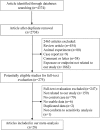Associations Between Risk Factors and Overactive Bladder: A Meta-analysis
- PMID: 29528879
- PMCID: PMC6493696
- DOI: 10.1097/SPV.0000000000000531
Associations Between Risk Factors and Overactive Bladder: A Meta-analysis
Abstract
Objective: The purpose of this study was to investigate the risk factors of overactive bladder (OAB).
Methods: The PubMed, Embase, and Cochrane Library databases were retrieved through May 2016. Odds ratios (OR) or standard mean differences (SMDs) with 95% confidence intervals (CIs) were used to evaluate the associations between risk factors and OAB. Heterogeneity among studies was examined using χ test based on the Q and I tests.
Results: A total of 28 articles were analyzed in our study. The results suggested that age and body mass index were significantly higher in OAB patients than in non-OAB controls (SMDs [95% CIs], 0.30 [0.19-0.41] and 0.39 [0.24-0.53]). A significant negative association was found between employment status and OAB (OR [95% CIs], 0.64 [0.46-0.90]). However, sex, educational level, parity, vaginal delivery, race, menopause, marital status, smoking, and alcohol consumption were not significantly different in OAB and non-OAB control patients (ORs [95% CIs], 0.95 [0.59-1.55], 1.04 [0.82, 1.33], 0.98 [0.56-1.70], 1.66 [0.90-3.07], 0.98 [0.75-1.28], 1.84 [0.23-14.70], 0.97 [0.78-1.19], 0.91 [0.77-1.08], and 0.88 [0.71-1.09], respectively). In addition, the number of parities and vaginal deliveries in OAB patients also showed no significant differences compared with non-OAB control patients (SMDs [95% CI], 0.05 [-0.27 to 0.38] and -0.16 [0.40 to 0.09]).
Conclusions: This meta-analysis suggests that age and body mass index are associated with increased risks of OAB, whereas employment status is associated with a decreased risk of OAB. Further prospective studies with large sample sizes are needed to confirm this conclusion.
Conflict of interest statement
The authors have declared they have no conflicts of interest.
Figures





References
-
- Abrams P, Cardozo L, Fall M, et al. The standardisation of terminology of lower urinary tract function: report from the standardisation sub-committee of the International Continence Society. Neurourol Urodyn 2002;21:167–178. - PubMed
-
- Irwin DE, Milsom I, Hunskaar S, et al. Population-based survey of urinary incontinence, overactive bladder, and other lower urinary tract symptoms in five countries: results of the EPIC study. Eur Urol 2006;50:1306–1314; discussion 1314–1305. - PubMed
-
- Milsom I, Abrams P, Cardozo L, et al. How widespread are the symptoms of an overactive bladder and how are they managed? A population-based prevalence study. BJU Int 2001;87:760–766. - PubMed
-
- Stewart WF, Van Rooyen JB, Cundiff GW, et al. Prevalence and burden of overactive bladder in the United States. World J Urol 2003;20:327–336. - PubMed
-
- Martinez Agullo E, Ruiz Cerda JL, Gomez Perez L, et al. (Prevalence of urinary incontinence and hyperactive bladder in the spanish population: results of the EPICC study). Actas Urol Esp 2009;33:159–166. - PubMed
Publication types
MeSH terms
LinkOut - more resources
Full Text Sources
Other Literature Sources
Medical

